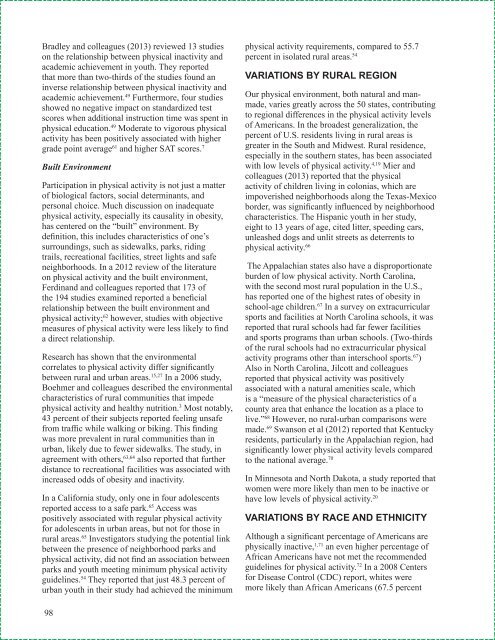1Cb1NJ5
1Cb1NJ5
1Cb1NJ5
You also want an ePaper? Increase the reach of your titles
YUMPU automatically turns print PDFs into web optimized ePapers that Google loves.
Bradley and colleagues (2013) reviewed 13 studies<br />
on the relationship between physical inactivity and<br />
academic achievement in youth. They reported<br />
that more than two-thirds of the studies found an<br />
inverse relationship between physical inactivity and<br />
academic achievement. 49 Furthermore, four studies<br />
showed no negative impact on standardized test<br />
scores when additional instruction time was spent in<br />
physical education. 49 Moderate to vigorous physical<br />
activity has been positively associated with higher<br />
grade point average 61 and higher SAT scores. 7<br />
Built Environment<br />
Participation in physical activity is not just a matter<br />
of biological factors, social determinants, and<br />
personal choice. Much discussion on inadequate<br />
physical activity, especially its causality in obesity,<br />
has centered on the “built” environment. By<br />
definition, this includes characteristics of one’s<br />
surroundings, such as sidewalks, parks, riding<br />
trails, recreational facilities, street lights and safe<br />
neighborhoods. In a 2012 review of the literature<br />
on physical activity and the built environment,<br />
Ferdinand and colleagues reported that 173 of<br />
the 194 studies examined reported a beneficial<br />
relationship between the built environment and<br />
physical activity; 62 however, studies with objective<br />
measures of physical activity were less likely to find<br />
a direct relationship.<br />
Research has shown that the environmental<br />
correlates to physical activity differ significantly<br />
between rural and urban areas. 15,27 In a 2006 study,<br />
Boehmer and colleagues described the environmental<br />
characteristics of rural communities that impede<br />
physical activity and healthy nutrition. 3 Most notably,<br />
43 percent of their subjects reported feeling unsafe<br />
from traffic while walking or biking. This finding<br />
was more prevalent in rural communities than in<br />
urban, likely due to fewer sidewalks. The study, in<br />
agreement with others, 63,64 also reported that further<br />
distance to recreational facilities was associated with<br />
increased odds of obesity and inactivity.<br />
In a California study, only one in four adolescents<br />
reported access to a safe park. 65 Access was<br />
positively associated with regular physical activity<br />
for adolescents in urban areas, but not for those in<br />
rural areas. 65 Investigators studying the potential link<br />
between the presence of neighborhood parks and<br />
physical activity, did not find an association between<br />
parks and youth meeting minimum physical activity<br />
guidelines. 54 They reported that just 48.3 percent of<br />
urban youth in their study had achieved the minimum<br />
physical activity requirements, compared to 55.7<br />
percent in isolated rural areas. 54<br />
VARIATIONS BY RURAL REGION<br />
Our physical environment, both natural and manmade,<br />
varies greatly across the 50 states, contributing<br />
to regional differences in the physical activity levels<br />
of Americans. In the broadest generalization, the<br />
percent of U.S. residents living in rural areas is<br />
greater in the South and Midwest. Rural residence,<br />
especially in the southern states, has been associated<br />
with low levels of physical activity. 4,19 Mier and<br />
colleagues (2013) reported that the physical<br />
activity of children living in colonias, which are<br />
impoverished neighborhoods along the Texas-Mexico<br />
border, was significantly influenced by neighborhood<br />
characteristics. The Hispanic youth in her study,<br />
eight to 13 years of age, cited litter, speeding cars,<br />
unleashed dogs and unlit streets as deterrents to<br />
physical activity. 66<br />
The Appalachian states also have a disproportionate<br />
burden of low physical activity. North Carolina,<br />
with the second most rural population in the U.S.,<br />
has reported one of the highest rates of obesity in<br />
school-age children. 67 In a survey on extracurricular<br />
sports and facilities at North Carolina schools, it was<br />
reported that rural schools had far fewer facilities<br />
and sports programs than urban schools. (Two-thirds<br />
of the rural schools had no extracurricular physical<br />
activity programs other than interschool sports. 67 )<br />
Also in North Carolina, Jilcott and colleagues<br />
reported that physical activity was positively<br />
associated with a natural amenities scale, which<br />
is a “measure of the physical characteristics of a<br />
county area that enhance the location as a place to<br />
live.” 68 However, no rural-urban comparisons were<br />
made. 69 Swanson et al (2012) reported that Kentucky<br />
residents, particularly in the Appalachian region, had<br />
significantly lower physical activity levels compared<br />
to the national average. 70<br />
In Minnesota and North Dakota, a study reported that<br />
women were more likely than men to be inactive or<br />
have low levels of physical activity. 20<br />
VARIATIONS BY RACE AND ETHNICITY<br />
Although a significant percentage of Americans are<br />
physically inactive, 1,71 an even higher percentage of<br />
African Americans have not met the recommended<br />
guidelines for physical activity. 72 In a 2008 Centers<br />
for Disease Control (CDC) report, whites were<br />
more likely than African Americans (67.5 percent<br />
98


